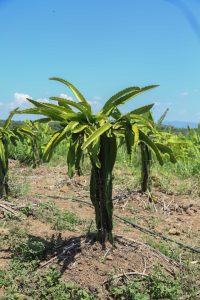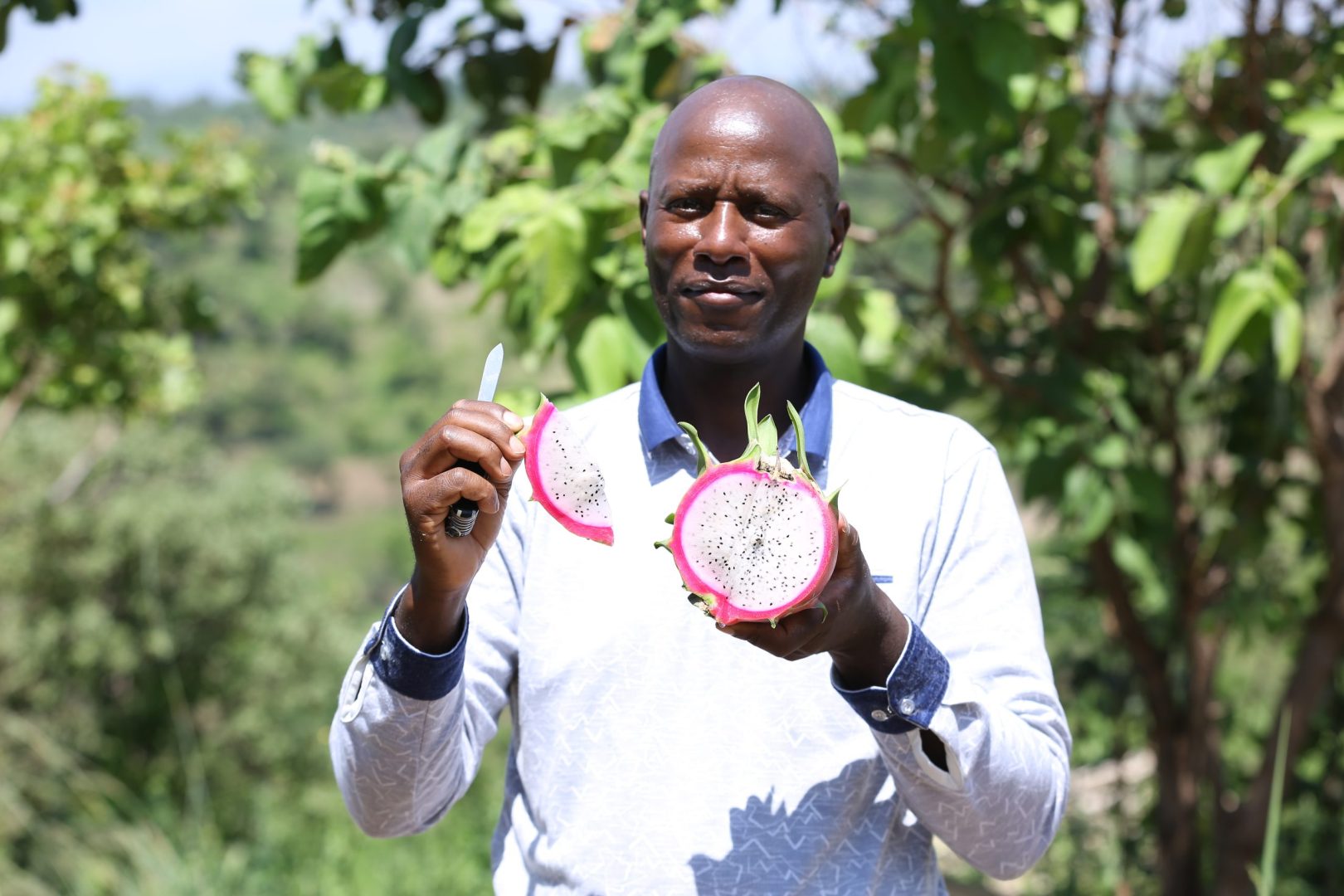A tropical fruit offering many health benefits is gaining popularity among Kenyan agripreneurs. The dragon fruit, which falls in the cactus family, originated from Central-South America and is very popular in Asia, especially Vietnam.
The fruit, also known as Pitaya, has a vibrant red skin and sweet, seed-speckled pulp. Its unique look and acclaimed ‘superfood’ powers have also made it popular amongst health-conscious consumers.
The fruit’s history in Kenya goes back to 2014 when research and development initiatives started. It can thrive in all soil types as long as they are well-drained and not waterlogged. The dragon fruit does well in Arid and Semi-Arid Lands (ASAL), giving great potential to turn around the regions. The fruit is also ideal for urban farmers as it can be sown in containers.
In the agriculture rich Meru County, we meet Anthony Kinoti Mugambi, one of the dragon fruit pioneer farmers in Kenya. Mr Mugambi’s farm, located in Kathuura village in Central Imenti, is well dotted with exotic fruits including the dragon fruit, which you can mistake for a bitter herb until you taste it.
“I was introduced to dragon fruit farming by a Chinese friend about seven years ago. In 2016, the now defunct Nakumatt supermarkets used to stock dragon fruits and a kilo used to retail at KShs2,000, but it was always off the shelves. Those who are health conscious used to book and buy the fruit. Out of this, the interest grew not just because of health benefits but as an agribusiness venture. That is how I started farming the fruit,” he says.
There are three main varieties of dragon fruit: Hylocereus undatus, (Pitaya blanca or white-fleshed pitaya); Hylocereus costaricensis (Pitaya roja or red-fleshed pitaya); and Hylocereus megalanthus (Pitaya amarilla or yellow-fleshed pitaya).
Mr Mugambi says the easy way to grow the fruit is from cuttings obtained from a mature plant. “You can start from cuttings which take between 9 months to 1.5 years to mature depending on ecological zone, but if you start from the seedlings, it will take at least 6 – 7 years to mature. Root it in a nursery, and then transplant it to the field,” he adds.
On his part, however, he started from the basics (seeds), but now he has enough propagation materials where he gets his cuttings. Since the dragon fruit is a climbing cactus, once it reaches 12 inches tall, it needs a support system to continue growing. A poll or wood stake is set up and the plant is trained up the post until it reaches the canopy and then trained to hang down like an umbrella. This method is called “top mop” facing down. When they start hanging down, that’s when they start fruiting.
“They will produce a fruit from the zones where there are thorns. It takes only 13 days for the fruit bud to grow into a flower. Dragon fruit flowers at night (and only one night). The following morning the flower has withered and wilted,” Mr Mugambi explains. “If it is not pollinated, too bad for you. If it is pollinated, it takes 38 days to harvest.”
Once it matures, the fruit is consumed raw or used in adding value to other products such as juices and yoghurts. The flesh of the dragon fruit is low in calories and is fat-free. It contains plenty of fibre which is good for gastrointestinal and cardiovascular health, and people who eat whole, fibre-rich foods are more likely to maintain a healthy weight. The fruit also contains vitamins, proteins, carbohydrates, iron, and magnesium, and it is also rich in antioxidants.

The weight of the fruits varies according to size with a small fruit weighing about 250g, medium sized fruits 500g, large sized fruits at 750 – 850g, and very large sized fruits above 1kg. “The fruit is priced by weight. 1g is KShs1. So, a fruit that weighs 500g goes for KShs500,” says Mr Mugambi.
The farmer has been able to consolidate clients. “Those who have not eaten the fruit are a market by themselves. Those who are health conscious are also a market. The demand is higher than supply.” He also propagates vines which retail at KShs500 apiece.
The World Agroforestry says dragon fruits bear within six to nine months and yields can be obtained from the second year onwards. The average yield is about 10 -12,000Kg/ha at the end of the third year. With proper management of the vines and fruit thinning improves the size of the fruits and yield. The average fruit weighs about 350g. The flowers and fruits can be thinned to improve and maintain fruit size and quality, which is important when producing for export markets.

However, Mr Mugambi says, a commercial orchard needs not be very large. “You can start with half an acre of land. It will require 1,000 plants and 250 posts with a spacing of about 5 by 3 metres.” He, however, advises prospective farmers to get their planting materials from a certified source. “You are welcomed, there is insatiable demand for the fruit in the country and abroad, and we are not able to meet the demand.”
According to World Agroforestry, there is considerable potential for the expansion of dragon fruit cultivation in most of the countries where it is presently being grown. Once planted, it will grow for about 20 years. The yields are also high and its regular bearing and precocious early yielding ability brings early income to the farmers.
More importantly, there is a growing export demand to the developed countries. Further, it is also possible to grow dragon fruit organically, which is particularly demanded by the European markets.

 Anthony Kinoti Mugambi, a dragon fruit farmer from Meru displays the fruit.
Anthony Kinoti Mugambi, a dragon fruit farmer from Meru displays the fruit.









